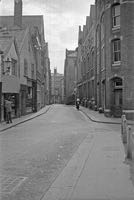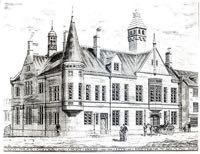
Waterbeer Street
Page updated 14th May 2017
Back to the Streets List
Also see these memories
Waterbeer Street in the 1930's
Waterbeer Street in the 1920's
 The shadow of the modern Waterbeer Street, hides the history of one of Exeter's most interesting streets. Although only 440ft (135 metres) long,
Waterbeer Street runs through
the
three ancient parishes of St Pancras, St Petrock and St
Kerrian. The line of the street, parallel with the High Street,
may go back as far as the Romans, and the discovery of Roman artifacts
and a mosaic floor indicates the possible site of the Roman seat of
justice or Prætorium on the site of the Looking Forward bronze.
The shadow of the modern Waterbeer Street, hides the history of one of Exeter's most interesting streets. Although only 440ft (135 metres) long,
Waterbeer Street runs through
the
three ancient parishes of St Pancras, St Petrock and St
Kerrian. The line of the street, parallel with the High Street,
may go back as far as the Romans, and the discovery of Roman artifacts
and a mosaic floor indicates the possible site of the Roman seat of
justice or Prætorium on the site of the Looking Forward bronze.
The established meaning of Waterbeer Street is as 'water-bearers street' and was first recorded in 1253, when it appears on a deed as 'Waterberestrete' and later in 1327 as 'Waterber Strete'. It may well relate to the ecclesiastical office of bearer of holy water. However, there is a possible alternative meaning originating from the wool trade. Weavers used to refer to nineteen ends of yarn running together out of a trough of water as a beer. It was speculated that such troughs existed in Waterbeer Street, giving it its name. It is a less likely explanation, if the street was first named in the 13th century, before the woollen industry was established. Another possible source of the word beer is the 11th century berge, meaning hill, which in Devon is corrupted to beare as in Aylesbeare and Dunsbeer, and hence Water Berge (Hill) Street
In 1694, a water engine was installed on the
leat,
just below Head Weir, to pump water into the city. A lead lined
cistern, known as the Back Grate measuring 28 ft by 18 ft was
constructed at the rear of the Guildhall, over the cells to hold the
water. The water company was required to ensure that the gaol
beneath the tank was maintained for the custody of prisoners, although
they did suffer from leaks. The street really did earn its name, as a
stream of water carriers would fill their buckets and barrels which
they would then sell a penny a bucket.
On 30th December 1734, the Exeter Theatre, the first purpose built theatre in the
city, was opened in Waterbeer Street, roughly on the present day site
of the 'Looking Forward' bronze in the Guildhall Centre. It was accessed through a passageway from Waterbeer Street itself. This theatre presented productions
between October and April each year, seldom repeating a play, giving
a huge variety of entertainment for the local population. The street
was named Theatre Lane for a while, but reverted to Waterbeer Street
after the theatre closed in 1787, when the Methodists bought the building with the intention of closing the theatre.
The Police Station
The foundation stone of Exeter's central police station and court house was laid on 13 July 1887 by Arthur Burch, the Mayor. The building, on the same site as the Exeter Theatre, was completed in 1888. Designed by J M Pinn and costing £4,750, it had a distinctive round tower on the corner with a conical roof. A Roman mosaic floor of the Prætorium was discovered during the demolition work required to clear the site, 2ft below the surface. The fragments were preserved and relaid at the foot of the Court staircase. When the building was demolished, the mosaic floor was removed to the Royal Albert Museum, only to be lost when a new curator thought it to be Victorian in origin. Although designed for the exclusive use of the police and courts, until 1901, the building was shared with the town clerk and his staff. Up until 1919, council wages were paid from the police station, resulting in upwards of 50,000 callers per year for their pay-packets. In 1959, the police vacated the building and moved into new premises at Heavitree Road.
Other buildings
A building on the opposite corner of Pancras Lane was a former Danish Bacon factory, that was also used by the police service for parades. The bacon factory had formerly been occupied by the Western Morning News up to 1934 and Frederick Algar, ironmonger up to 1925.
A well known business in the street was Brookings, who ran a jewellers, a second hand shop and a pawnbrokers. Mr Brooking held the certificate for testing the accuracy of police stop watches that were used to time a car travelling between two set points, to see if it were speeding - consequently, before the Road Traffic Act of 1964, there was a stream of coppers in and out of Brookings, having their watches checked.
A billiard hall at No 3, was run by W A A Oliver in 1961, and in 1967 it was the Davey and Bealey billiard rooms. remembered fondly by many, especially as they had been warned by their parents not to frequent it because of the supposedly sleazy clientele. The entrance was opposite the rear of Woolworths.
When the coroners court was sitting, a policeman was sent out to find people to sit on the jury - he would take people off the street, often men from Garton and King on the way to work. Eventually, agreement was made that they would not use Garton and King employees on days that they were casting. Oddly, there was also the French Consul in Waterbeer Street.
Industry in the heart of the city
Rowe Bros and Co at No 3, paint manufacturers and plumbers, and Garton and King at No 4 and 6, iron and brass foundry, were located right in the centre of the city, just where the modern Trichay Street crosses Waterbeer Street. The first Garton and King foundry in the street was constructed on the site of what Jenkins' referred to as a Praetorium or Town Hall, in this extract from his history of the city.
In Waterbeer-street, in this parish, lately stood a very ancient building; it originally consisted of three semicircular arches, supporting an angular front, with an arched window in the centre: those arches or gateways led into a spacious hall, which (according to tradition) was the Praetorium or Town-hall; while some respectable antiquarians judge it to be the remains of a religious edifice; * but this does not seem probable from the structure of the building, it having no remains of a vaulted roof, neither had it any of those grotesque embellishments so common in the religious edifices of our Saxon ancestors; from its ruinous state it was of necessity taken, down in the year 1803, and capacious warehouses erected on its site, by Mr. Kingdom, Ironmonger, of this city.
Adjoining is a large ancient roomy house, bequeathed to the charity schools, and now appropriated as habitations for the schools. two Schoolmasters, with school-rooms for the boys.
Some considered it to be a religious building, but the lack of a vaulted roof suggests otherwise. Kingdon's warehouse and foundry was
destroyed by a fire in October 1826 and a new foundry built on the site
of the Episcopal Charity School, which had relocated to Paul Street (what is now Little Paul Street, behind the present Pitcher and Piano in Queen Street. On days that Garton and King were
casting, a pall of smoke from the chimney high above, would descend
onto the street like a fog. Both the foundry and Rowe's had cranes
attached to the front wall of their buildings, and the unloading and
loading from lorries and carts would often cause a
blockage in the narrow street. Rowe's also sold sheet lead, which they
would unroll in the street to measure and cut to size, leaving only
enough space for pedestrians to squeeze past.
Rowe's moved out to a new building in the 1920's on the site of the
old Victoria Hall in Queen Street,
while Garton and King relocated to a new foundry in Tan Lane, Haven
Banks, after the foundry was compulsorily purchased in 1939 to make way
for the area to be redeveloped as a new Civic Centre. The war
intervened to prevent the development, and it wasn't until the 1970s
that the Golden Heart project saw the building of the Guildhall
Shopping Centre.
Sources: Various other pages in Exeter Memories, and the British Newspaper Archive.

The 'so called' Praetorium or Town Hall was replaced by a warehouse for Samuel Kingdon in 1803. The side entrance to Wilkinsons (formerly Woolworths) stands on this site.

Looking towards North Street in 1936. The Garton and King Foundry is the third shop from the corner of North Street, on the right.

The Silver Jubilee Looking Forward bronze from 1977 in the distance. Work starting on the new Marks and Spencers. Photo David Cornforth 1979.

The three shops in Waterbeer Street that were Brookings, before the Guildhall Centre was constructed – the shop with the clock was the central of the trio. Photo Alan H Mazonowicz.
Some Pubs in Waterbeer Street
Angel Inn – in September 1814 a fire was recorded at the inn, with the stables, brew house, and the outhouses destroyed. The report noted that the premises had 'been on fire three times within the space of twelve months'. It became the Commercial Inn in June 1823.
The Criterion – No 31(thought to be next to Parliament Street) – only listing in 1889, although a lease from the Well Park Brewery to James Pulsford the drapers, was signed in 1903. Pulsfords were still going strong in the 60s. They were a sizeable shop, more wholesale than retail, where they sold children's clothes in the main, but also shirts etc.
Half Moon – on the corner of North Street it was mentioned in 1791, and listed in 1850.
New Market Inn – No 19 - on the corner with Goldsmith Street, it was listed between 1844 and 1940. Norman and Pring purchased it in 1897 and leased it to William Tucker.
Plymouth Arms – trading in 1853 - there was a lease dated 1872 to Thomas Raddon. On the corner of North Street.
Chair – circa 1768 to 1830, it became the Smiths Arms.
The Turks Head – rear entrance
Union Inn – listed between 1816 and 1850.
│ Top of Page │



